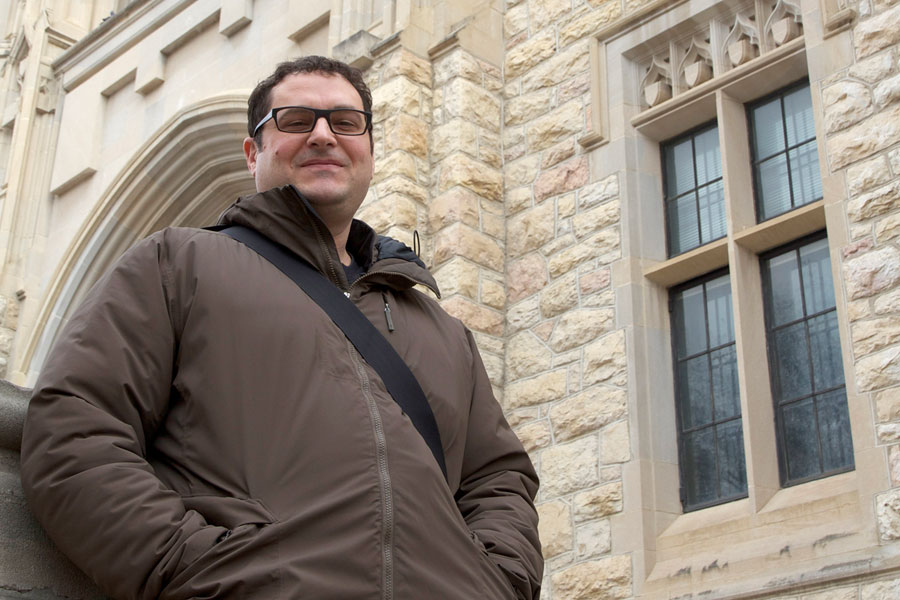Preservation guide for campus
About three years ago, someone suggested the President’s Residence be torn down to allow more development along the riverbank edge of campus, a suggestion that horrified many, including Andrew Wallace. But it also spurred him on to tackle a project designed to recognize the significance of the remarkable buildings that make up the University of Saskatchewan.
By Colleen MacPherson "I was alarmed," said Wallace, an architect and associate director of space planning in the Facilities Management Division (FMD). "The President's Residence is a heritage building; any reasonable person can see it's a heritage building and it's probably the best heritage house in Saskatoon but it has no formal protection." So Wallace, along with fellow architect and associate vice-president of facilities Colin Tennent, set out to create a guide to preserving what they view as one of the university's most valuable assets. The result is the U of S Heritage Register.
"I was alarmed," said Wallace, an architect and associate director of space planning in the Facilities Management Division (FMD). "The President's Residence is a heritage building; any reasonable person can see it's a heritage building and it's probably the best heritage house in Saskatoon but it has no formal protection." So Wallace, along with fellow architect and associate vice-president of facilities Colin Tennent, set out to create a guide to preserving what they view as one of the university's most valuable assets. The result is the U of S Heritage Register.
Wallace explained that heritage buildings can currently have three levels of protection— municipal, provincial or federal designation. The Stone School House and Rugby Chapel are municipal heritage buildings and the Peter MacKinnon Building has both provincial and federal protection. Unfortunately, those designations come with rules and approval procedures that often make it difficult for owners to renovate, restore or expand structures.
The solution was an internal register. "We know how to recognize heritage value," said Wallace, "and with our own guide, we can impose our own requirements for preserving and protecting our buildings."
The first step was deciding which campus buildings and sites belonged in the register. Wallace said the evaluation used the same considerations as other heritage designations, "character-defining elements" like age, quality of construction, design, spatial configuration and materials. The evaluation criteria were based on Parks Canada's Standards and Guidelines for the Conservations of Historic Places in Canada , which Wallace said is the gold standard across the country in heritage building recognition and conservation.
"There's some subjectivity to it," he admitted, "but it's informed subjectivity."
With the help of Megan Fritzler, an architecture master's student from the University of Calgary, 41 buildings were short listed for further inspection, evaluation and documentation of their features. "This builds a weight of evidence if there's something important about the building," he said.
In the end, the register divides the buildings and sites into three categories of asset. The first, an A list of 18, requires that any work be carried out in accordance with the Parks Canada standards. The B list, which numbers 16, are buildings and sites where it is recommended but not required that the standards be followed.
The remaining seven buildings have no formal protection but are included in the register because they have some heritage features that need to be considered when alterations are required, Wallace said.
The resulting Heritage Register is a comprehensive, and beautiful, document. The entry for each building includes archival materials like original drawings, detailed descriptions and stunning photographs of the buildings themselves and the various elements that make them special.
Wallace said the register will be valuable to both FMD and consulting architects involved in renovation or expansion projects. "It doesn't force the university's hands to carry out any particular project but it does say that if we're going to do a project, here's how to do it right. It doesn't say we can't add on to the Thorvaldson Building, for example, but if we do, the register will guide how the work is done. It comes down to a very simple principle—you ought to take the least invasive approach possible."
What is interesting about the register is that while many obvious buildings—the Collegiate Gothic collection—are included, others on the list may be a surprise. Wallace reiterated age is not the only determining factor, and that is why the work of architect John Holliday Scott like the Law/Commerce Building from 1967 and the Dentistry Building from 1979 made the registry.
"These are very, very good examples of modernist architecture," he said. The Law Building is a particular favourite for Wallace. "I have real admiration for Holliday-Scott having done such thorough work. Law has beautiful spaces, there is a lot of rigour to its design and it's expressive of both its time and historical context. And it's cheeky and playful. I actually laughed out loud when I first noticed things like its references to spires and battlements.
"The university has very good examples of all of the major architectural styles of the 20th century and they all fit together. When we only think of the original buildings on campus, we overlook some really good architecture."
Wallace's passion for heritage architecture is evident as he turns the pages of the register which will soon be viewable online. "I think we've done something pretty unique. Most universities do what we used to do, and that is to take a more ad hoc approach to heritage preservation. I'm looking for opportunities to present this at conferences because I don't think any other university has this level of documentation. I'm very proud of it.

